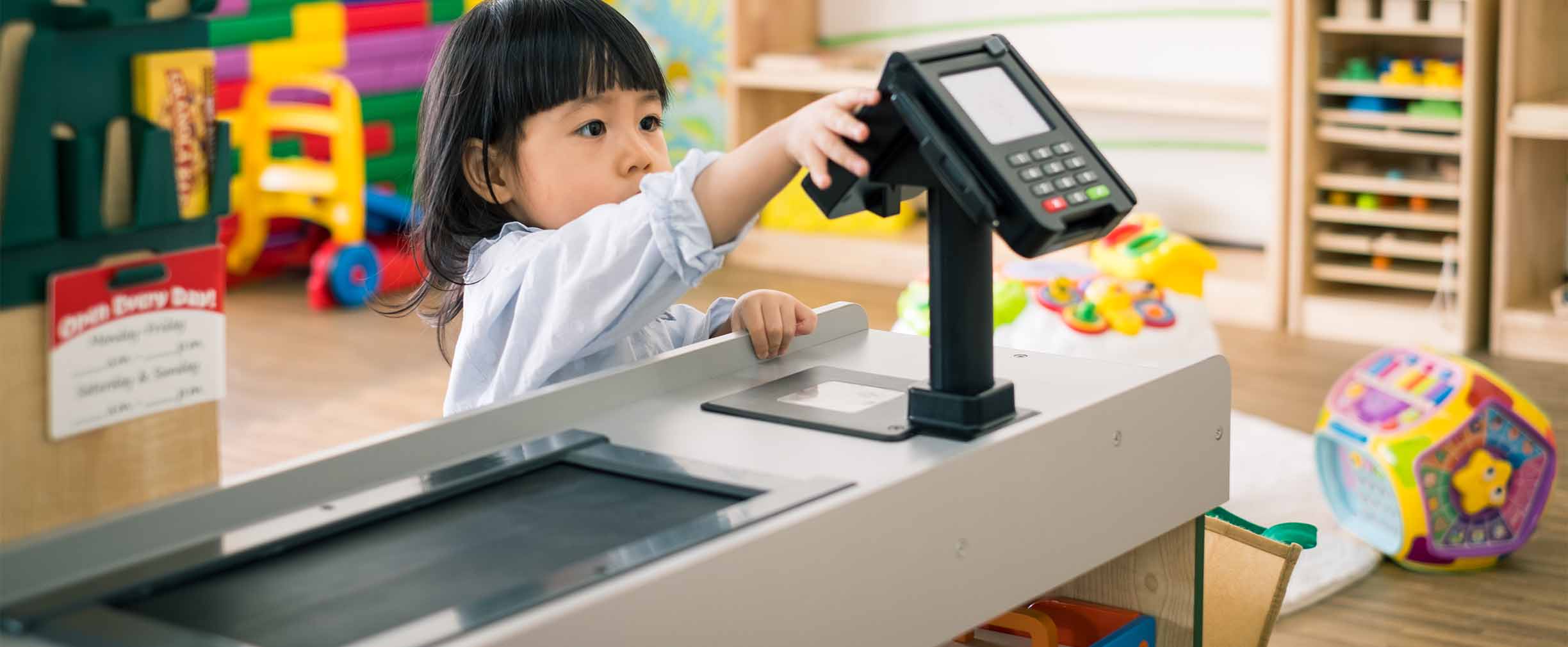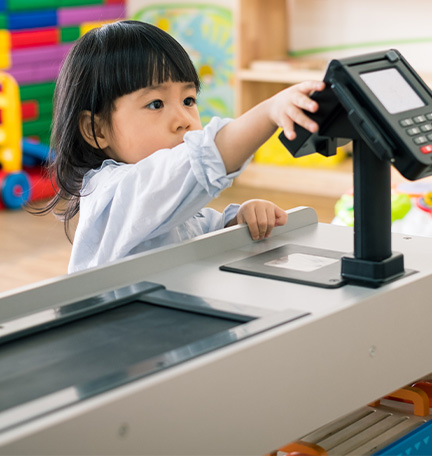Start early and try to make saving and spending fun at first.
Money is a huge part of our adult lives, and as a parent, you have the responsibility to kick-start your children’s financial education. But just because money is a serious topic doesn’t mean that teaching kids the basics has to be daunting—or tedious. You won’t need to start with stocks and bonds and interest rates. Instead, you can start by playing around.
“Kids understand cause and effect at an early age,” says Erin Reece, Wealth Advisor, Regions Bank. “They understand ‘if I have this amount or earn this amount, I can purchase X, Y or Z.’ So we have an opportunity to begin teaching them through functional play at an early age.”
Your main goal should be to instill your children with good, responsible money habits. If you can do that, they’ll reap the rewards throughout their lives. Here are some ideas to consider as you get started:
Start when your kids are young
Even toddlers can grasp some basics, so engage your preschoolers in functional play. For example, playing storefront types of games that involve the purchase and sale of goods can be a teaching opportunity. You can also:
- Encourage them to earn and save. Once children reach elementary school, receive an allowance and can earn money through things like pet sitting and setting up a lemonade stand, they can begin to save money. Encourage it and show them how to save by setting money aside each time they earn some. When they are young, it doesn’t need to be an exact percentage—just enough to make a point.
- Help them visualize progress. Even young children, who may lack advanced math skills, can easily visualize their progress toward a savings goal. Reece says that when her son wanted a water gun, she represented it with an illustration and drew marks for each dollar saved toward the total. That served as a powerful visual reminder of the progress he was making. “We’ve got to be able to show them how we visualize goals,” she says. “With smaller kids, you can simply do things like draw the picture and check off the boxes.”
- Show them coupons and plan menus. You know those weekly grocery store flyers in your mailbox and at the checkout counter? A practical family interactive money lesson is to clip coupons from them and build a meal around smart spending. “‘Buy one, get one free’ is a simple and easy-to-grasp concept,” Reece says. This is also a good example of role modeling by parents.
Teach older children financial responsibility
When kids start to get older, their needs and wants can grow more complicated. They will understand money better, but they still will need guidance on saving and spending.
“As examples of wants, teenage girls will happily spend money on makeup and trendy, fashionable clothes, while teenage boys might covet a pair of expensive sneakers,” Reece says. They should know the difference between their necessities and these desires and behave accordingly. Here’s where to start:
- Deter impulsive spending. Once children reach middle school, they could be earning more money through part-time jobs and becoming more independent. This is a great time to teach them to deter impulsive spending, which isn’t easy in the face of the constant pressures to purchase based on advertising and their peers.
- Follow the 50/30/20 budget rule. This basic budgeting rule says you should spend 50% of your income on must-have items, such as groceries, car loan payments and gas and maintenance for that vehicle. Then, 30% can go toward things you want but don’t truly need. And finally, 20% should be saved. This formula can serve as a guideline for children to follow as they become more independent.
- Introduce more complex topics. Every child is different, but as they become older, you should teach them about credit, interest, investing and even retirement planning. You don’t need to sit down with them and explain the nuances of portfolio management, but general conversations about how money can be used to reach short- and long-term goals will help them gain perspective on the value of a dollar.
Role modeling can be powerful
The greatest impact parents can have is to lead by their own example. That means parents should limit their own impulsive spending. They also should involve children in discussing family spending choices, such as how, when and where to vacation, bringing in cost considerations.
- Stay positive and empower your children. Avoid creating a scarcity mentality by saying things are too expensive. Instead, explore how you can work toward an achievable financial goal. That can help to instill responsibility while empowering your children.
- Have your children participate financially. They can benefit from having some skin in the game. If you make it clear that your children will contribute to saving for a car or for college tuition, they will take ownership of those quests and will learn the value of a dollar and hard work. They will also feel a sense of pride and accomplishment. “Say your child saved $5,000 toward a car, and you promised to match that $5,000 for a down payment,” says Reece. “Go a step further and sit down with them and say, for the car they want, their monthly payment will look like this. Actually sitting down and doing the math together will help them do it on their own next time.”
Value values and practice gratitude
Focus on values as well as considering value. Encourage your children to appreciate the simple things in life, not just material wealth. Teach them to place value in themselves rather than feel the need to buy into the idea that possessing something gives them greater status.
Talk to your Regions Wealth Advisor about:
- How and when you should introduce financial topics to your children based on their ages.
- What resources from Regions Bank’s Next Step program may be helpful.
Interested in talking with an advisor but don’t have one?
Find a contact in your area.











